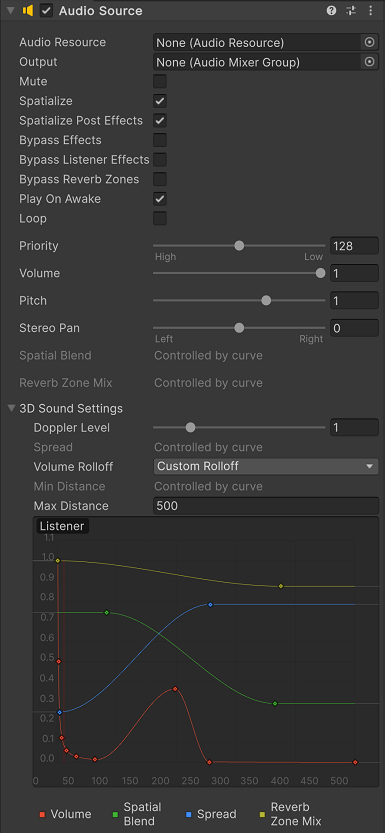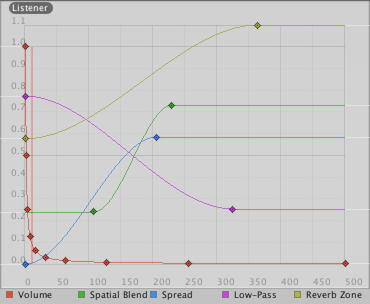How To Put In Background Music Into Unity
Sound Source
The Sound Source plays back an Sound Clip in the scene A Scene contains the environments and menus of your game. Think of each unique Scene file every bit a unique level. In each Scene, yous identify your environments, obstacles, and decorations, substantially designing and building your game in pieces. More than info
See in Glossary . The clip can be played to an sound listener or through an audio mixer. The audio source can play whatever blazon of Audio Clip and can be configured to play these every bit second, 3D, or as a mixture (SpatialBlend). The audio can exist spread out between speakers (stereo to vii.1) (Spread) and morphed between 3D and 2d (SpatialBlend). This can exist controlled over distance with falloff curves. Also, if the listener is within ane or multiple Reverb Zones, reverberation is practical to the source. Individual filters can be applied to each audio source for an fifty-fifty richer audio experience. See Audio EffectsAny consequence that tin can modify the output of Audio Mixer components, such every bit filtering frequency ranges of a audio or applying reverb. More info
Run into in Glossary for more than details.

Properties
| Property: | Function: |
|---|---|
| Audio Prune A container for audio data in Unity. Unity supports mono, stereo and multichannel audio assets (up to 8 channels). Unity can import .aif, .wav, .mp3, and .ogg audio file format, and .xm, .mod, .it, and .s3m tracker module formats. More info See in Glossary | Reference to the audio clip file that will be played. |
| Output | By default, the clip is output directly to the Audio Listener in the Scene. Use this property to output the prune to an Audio Mixer instead. |
| Mute | If enabled the audio volition exist playing but muted. |
| Bypass Effects | This is to quickly "by-laissez passer" filter furnishings practical to the audio source. An easy way to turn all effects on/off. |
| Bypass Listener Effects | This is to chop-chop turn all Listener effects on/off. |
| Bypass Reverb Zones | This is to quickly plow all Reverb Zones on/off. |
| Play On Awake Set this to true to make an Sound Source outset playing on awake More info Meet in Glossary | If enabled, the audio will start playing the moment the scene launches. If disabled, you lot need to showtime information technology using the Play() command from scripting. |
| Loop | Enable this to make the Audio Prune loop when it reaches the cease. |
| Priority | Determines the priority of this audio source among all the ones that coexist in the scene. (Priority: 0 = most important. 256 = least important. Default = 128.). Use 0 for music tracks to avoid it getting occasionally swapped out. |
| Volume | How loud the sound is at a altitude of 1 world unit (ane meter) from the Audio Listener A component that acts like a microphone, receiving sound from Audio Sources in the scene and outputting to the computer speakers. More info See in Glossary . |
| Pitch | Amount of change in pitch due to slowdown/speed up of the Audio Prune. Value one is normal playback speed. |
| Stereo Pan | Sets the position in the stereo field of 2D sounds. |
| Spatial Blend | Sets how much the 3D engine has an effect on the sound source. |
| Reverb Zone Mix | Sets the amount of the output betoken that gets routed to the reverb zones. The amount is linear in the (0 - 1) range, but allows for a x dB distension in the (1 - i.1) range which can be useful to achieve the effect of most-field and distant sounds. |
| 3D Sound Settings | Settings that are applied proportionally to the Spatial Blend parameter. |
| Doppler Level | Determines how much doppler effect will be applied to this sound source (if is set to 0, then no event is applied). |
| Spread | Sets the spread angle to 3D stereo or multichannel sound in speaker space. |
| Min Distance | Within the MinDistance, the sound volition stay at loudest possible. Outside MinDistance it will brainstorm to attenuate. Increase the MinDistance of a sound to make it 'louder' in a 3d earth, and decrease information technology to make information technology 'quieter' in a 3d world. |
| Max Distance | The distance where the audio stops attenuating at. Beyond this indicate it volition stay at the volume information technology would be at MaxDistance units from the listener and will non benumb whatsoever more. |
| Rolloff Mode | How fast the sound fades. The college the value, the closer the Listener has to be before hearing the sound. (This is adamant past a Graph). |
| - Logarithmic Rolloff | The audio is loud when yous are close to the audio source, merely when yous get abroad from the object it decreases significantly fast. |
| - Linear Rolloff | The further away from the audio source you get, the less you can hear it. |
| - Custom Rolloff | The audio from the sound source behaves accordingly to how you set the graph of curlicue offs. |
Types of Rolloff
In that location are three Rolloff modes: Logarithmic, Linear and Custom Rolloff. The Custom Rolloff can be modified by modifying the book distance curve every bit described below. If you endeavour to modify the volume distance function when it is set to Logarithmic or Linear, the type volition automatically change to Custom Rolloff.

Distance Functions
At that place are several properties of the audio that can be modified equally a part of the altitude betwixt the sound source and the audio listener.
Volume: Amplitude(0.0 - 1.0) over distance.
Spatial Alloy: 2D (original channel mapping) to 3D (all channels downmixed to mono and attenuated according to distance and direction).
Spread: Angle (degrees 0.0 - 360.0) over distance.
Low-Pass (only if LowPassFilter is attached to the AudioSource): Cutoff Frequency (22000.0–10.0) over distance.
Reverb Zone: Amount of signal routed to the reverb zones. Annotation that the volume property and altitude and directional attenuation are applied to the signal first and therefore affect both the straight and reverberated signals.

To modify the altitude functions, you can edit the curves directly. For more data, meet the guide to Editing Curves.
Creating Audio Sources
Audio Sources don't do anything without an assigned Audio Clip. The Clip is the actual sound file that will exist played dorsum. The Source is like a controller for starting and stopping playback of that clip, and modifying other audio properties.
To create a new Audio Source:
- Import your sound files into your Unity Project. These are now Audio Clips.
- Go to GameObject->Create Empty from the menubar.
- With the new GameObject selected, select Component->Sound->Sound Source.
- In the Inspector A Unity window that displays information about the currently selected GameObject, asset or project settings, allowing you to audit and edit the values. More info
See in Glossary , find the Audio Prune property on the Sound Source Component and assign a prune, either past dragging one from the Project Window A window that shows the contents of yourAssetsfolder (Project tab) More info
See in Glossary or by clicking the small-scale circumvolve icon to the right of the Inspector property, then selecting a clip from the list.
Note: If yous desire to create an Audio Source just for i Audio Clip that y'all accept in the Assets folder then you can but elevate that prune to the scene view An interactive view into the world you are creating. You utilize the Scene View to select and position scenery, characters, cameras, lights, and all other types of Game Object. More info
Run across in Glossary - a GameObject The fundamental object in Unity scenes, which tin can represent characters, props, scenery, cameras, waypoints, and more. A GameObject's functionality is defined by the Components fastened to information technology. More info
See in Glossary with an Audio Source component will be created automatically for it. Dragging a clip onto on existing GameObject will attach the prune forth with a new Audio Source if there isn't one already there. If the object does already take an Audio Source then the newly dragged clip will replace the 1 that the source currently uses.
API Resources
- AudioSource
- AudioClip
- AudioListener
- AudioMixer
How To Put In Background Music Into Unity,
Source: https://docs.unity3d.com/Manual/class-AudioSource.html
Posted by: becerrawituare.blogspot.com


0 Response to "How To Put In Background Music Into Unity"
Post a Comment